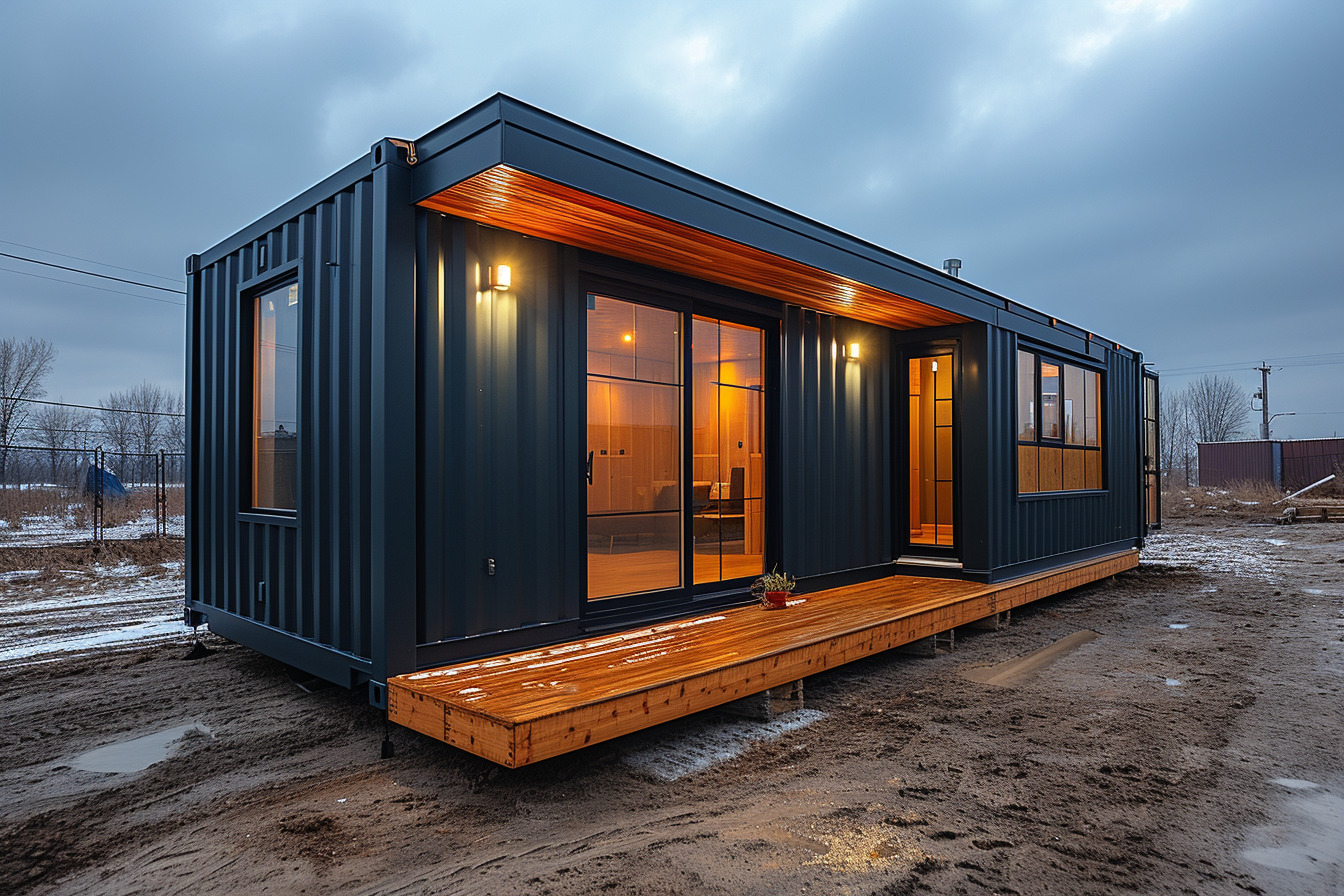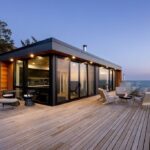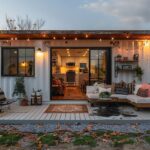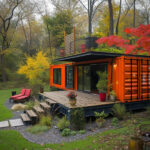Container cabins have taken the housing market by storm, creating sustainable and innovative solutions for living spaces. These repurposed shipping containers offer both functional and flexible accommodations, ranging from tiny homes and vacation retreats to eco-friendly hunting cabins. The allure of container cabins stems from their inherent strength, durability, and the ease with which they can be customized and transported.
The process of transforming a shipping container into a livable space involves several considerations, such as insulation, ventilation, and interior design. Companies specializing in container cabin construction leverage these structures’ modular nature, allowing for a variety of styles suited to different tastes and purposes. Individuals looking for modern, rustic, or rugged aesthetics will find container cabins to be surprisingly versatile. From a 20-foot cozy retreat to a spacious 53-foot abode, these cabins come in multiple sizes to cater to the diverse needs of explorers and homeowners alike.
Container cabins represent a confluence of functionality and environmental consciousness. Their rise in popularity underscores a growing trend towards minimalist and sustainable living. As adaptable as they are eco-friendly, container cabins open the door to living solutions that are as unique as the individuals who inhabit them. Whether employed as a tiny home or a remote hunting lodge, these inventive structures continue to challenge traditional housing concepts.

Container Cabins Overview
Container cabins leverage the strength and portability of shipping containers to offer a unique and sustainable housing solution.
Definition and Concept
Container cabins are habitable structures made from repurposed shipping containers. Designed initially for transporting goods, these steel containers are reimagined into compact, eco-friendly living spaces suitable for a variety of uses, ranging from remote cabins to urban homes.
History and Evolution
The history of container cabins traces back to cargo container innovations, ultimately evolving into architectural elements. Originally intended to streamline the global transport of goods, retired shipping containers began being transformed into buildings as a response to environmental concerns and housing demands. Their robust design naturally lent itself to a second life as modular, stackable, and transportable living spaces.
Design and Architecture
The design and architecture of container cabins emphasize innovative use of materials, space efficiency, and environmental sustainability. These aspects are crucial in creating functional, attractive, and eco-conscious living spaces.
Blueprints and Layouts
Container cabins are often designed with a focus on maximizing the limited space that the rectangular shape provides. Architects and designers create detailed blueprints to ensure that every inch is used efficiently. For instance, the Adriance House by Adam Kalkin showcases an intelligent use of twelve shipping containers, blending open spaces and private areas to form a cohesive home.
Aesthetics and Styles
The aesthetics of container homes range from industrial chic to modern simplicity. A key feature is the ability to maintain the container’s original character while incorporating contemporary design elements. An example is found in MB Architecture’s work, which demonstrates a balance between the raw, industrial look of containers and stylish, modern finishes.
Sustainability and Eco-friendliness
Sustainability is at the core of shipping container architecture. Designers often include features such as solar panels, as highlighted by the Canyon City Container Cabin, with its off-grid capabilities. Repurposing shipping containers into habitable structures also reduces the carbon footprint associated with new material use and construction.

Types of Container Cabins
Container cabins offer versatility and sustainability in construction, catering to various uses that range from simple housing to innovative business solutions and portable structures ideal for different purposes.
Residential
Residential container cabins provide an eco-friendly alternative to traditional cabin construction. They are often repurposed from shipping containers, transformed into compact living spaces. Common layouts include single-unit studios and multi-container family homes, both designed to maximize the limited space efficiently.
Commercial
Commercial container cabins are seeing increased use in business settings, such as on-site offices or pop-up shops. These container units are not only cost-effective but also offer a modern aesthetic and can be easily relocated, providing businesses with both a unique branding opportunity and flexibility.
Portable and Modular
Portability and modularity are standout features of container cabins. They can be designed as tiny homes or offices that are easily transportable to various locations. This modularity allows for the cabins to be expanded or reconfigured as needs change, making them suitable for temporary accommodations or emergency housing.
Purpose-Specific
Many container cabins are also designed for specific functions, such as hunting cabins or retreats. They can be customized to include amenities that cater specifically to their intended use, such as additional insulation for cold climates or reinforced structures for rugged terrain. Purpose-specific designs show off the ability of container cabins to be tailored to meet niche requirements.

Manufacturing Process
The manufacturing process of container cabins involves meticulous steps that ensure they are built to specifications, integrating strength, efficiency, and suitability for habitation.
Material Selection
Container cabins begin with the selection of durable materials, predominantly steel shipping containers, which offer structural integrity and resistance to environmental factors. The custom container homes are chosen based on their unique needs and location, ensuring that they are suitable for conversion into habitable spaces.
Fabrication and Assembly
The next step is the fabrication and assembly of the container. During this phase, containers might be cut, framed, insulated, and outfitted with utilities. Companies like CRATE emphasize a modular approach, where containers can be stacked and arranged for custom designs, taking advantage of the shorter turnaround time compared to traditional construction methods.
Quality Control and Standards
Quality control ensures all container cabins meet industry standards for safety and livability before they reach the client. This involves rigorous testing of structural components and infrastructure. Kubed Living underscores the importance of adhering to framing options and regulatory standards, whether using steel, shipping container, or lumber framing methods in the construction.
Uses and Applications
Container cabins are versatile structures that have been adapted for a variety of uses across different sectors. The following subsections outline some of the most common applications of container cabins.
Emergency and Disaster Relief
In the wake of disasters, container cabins provide a quick and reliable solution for on-site emergency shelters. They can be rapidly deployed to affected areas, offering a secure and weather-resistant haven for both victims and relief workers.
- Pros:
- Fast deployment
- Sturdy construction
Offices and Workspaces
Container cabins make for ideal temporary or permanent offices. They can be modified to include insulation, electrical wiring, and windows, creating comfortable and functional work environments for a wide range of industries.
- Advantages:
- Cost-effective
- Easily customizable
Recreational and Leisure
For recreational purposes, container cabins are often transformed into unique retreats or vacation homes. These can be found in remote locations, offering an eco-friendly and adventurous alternative to traditional building methods.
- Benefits:
- Eco-friendly
- Mobility
Storage and Facilities
The inherent strength and durability of container cabins have made them excellent choices for secure storage and specialized facilities like workshops. Their robust nature protects contents from theft and the elements.
- Features:
- High security
- Resilience to weather

Legal and Zoning Considerations
When considering the construction of container homes, individuals must navigate the complex landscape of building codes, permits and regulations, and zoning laws to ensure compliance.
Building Codes
Building codes are critical for the safety and integrity of container homes. They must meet structural standards for habitation, which includes proper insulation, electrical wiring, and plumbing systems. In some regions, such standards are not yet fully developed for container constructions, necessitating consultation with local building authorities to align with existing codes.
Permits and Regulations
Securing the appropriate permits is a mandatory step before construction can commence. The permit process involves submitting detailed plans and undergoing inspections to certify adherence to building codes. It is essential to acquire all necessary permits to avoid legal complications and potential removal of the structure.
Zoning Laws
Zoning laws dictate how land is utilized and what types of structures are permissible. They vary significantly, so it’s critical to research local laws. Some areas may have restrictions that impede container home construction, while others welcome it as a sustainable housing option. Compliance with zoning laws is essential to legally inhabit a container home in the desired location.
Advantages and Disadvantages
Container cabins offer unique benefits and also come with potential drawbacks that one must consider before choosing this type of structure.
Cost Efficiency
Container cabins are generally more affordable than traditional homes due to the repurposing of shipping containers as the main structural component, which can lead to significant savings in material costs. Benefits like these are making container homes an increasingly popular choice for budget-conscious homebuyers.
Mobility and Flexibility
One of the standout features of container cabins is their mobility. These structures can be relocated with relative ease, which is particularly advantageous in areas where land ownership may be temporary. Their modularity also offers great flexibility in design, allowing for expansion or reduction in size as needed.
Durability and Maintenance
Shipping containers are designed to withstand harsh weather and conditions at sea, which translates to high durability for container cabins. However, the steel construction requires proper insulation to maintain a comfortable interior climate and prevent issues related to temperature conductivity. Maintenance can be more involved due to the need to manage insulation challenges and prevent corrosion.
Customization and Personalization
Customization and personalization of container cabins offer the flexibility to tailor spaces to specific needs, ensuring that both the aesthetic and functional preferences of the customer are met.
Interior Design
Interior design choices in container cabins are diverse, aimed at maximizing space usage and reflecting individual style. Customers can select from various floor plans and custom options such as siding type, flooring material, cabinet designs, countertops, and additional features like lofts, kitchens, or bathrooms as seen at Custom Container Living.
Exterior Modifications
The exterior of a container cabin can be altered to enhance both functionality and visual appeal. Options include customizing exterior colors, choosing different types of lighting, and adding outdoor elements such as decks or terraces. Bob’s Containers illustrates a range of exterior customizations to fit the desires of any client through their Custom Container Home Options.
Technology and Smart Homes
Container cabins can be integrated with modern technology to transform into smart homes. Customers have the option to include advanced features like:
- Environmental controls (heating and cooling)
- Lighting systems
- Security features
These allow for a comfortable, energy-efficient, and secure living environment. XCaliber Container, for example, provides possibilities for such enhancements in their Shipping Container Cabins.
Market Trends and Predictions
The global market for container homes is witnessing a considerable upsurge, with financial assessments indicating a steady increase in market size. In 2021, the market’s valuation stood at USD 56.85 billion. One analysis projects growth from USD 59.27 billion in 2022 to USD 87.11 billion by 2029, representing a compound annual growth rate (CAGR) of 5.7%. This prediction underscores the developing interest in container homes as an affordable, eco-friendly housing solution.
| Year | Market Size (USD Billion) | CAGR |
|---|---|---|
| 2021 | 56.85 | – |
| 2022 | 59.27 | – |
| 2029 | 87.11 | 5.7% |
| 2032 (Proj.) | 92.2 | 5.33% |
- Consumer Trends: There is a growing preference for eco-conscious living, with many individuals looking towards container homes as a sustainable choice.
- Innovation and Design: Customization and innovative design are becoming key drivers in the market’s expansion.
- Regulatory Landscape: Governmental policies on building and zoning are adapting, in part aiding the market growth. However, regulatory barriers remain a notable challenge.
Researchers suggest that between 2024 and 2032, the market might grow at a slightly higher CAGR of 5.9%. With the global container homes market size having reached approximately USD 53.86 billion in 2023, these projections found at Container Homes Market Size also highlight the sector’s resilience and its anticipated trajectory towards a valuation of USD 75.96 billion by 2032. The escalating demand for cost-effective, modular housing is significantly contributing to the bullish market outlook.
Purchasing and Leasing Options
When looking to acquire container cabins, individuals and businesses have a range of options involving purchasing new or pre-owned units, entering leasing agreements, or exploring financing possibilities to make the investment more manageable.
Buying New and Pre-Owned
New container cabins are available from multiple manufacturers, offering customization and modern amenities, tailored to suit the buyer’s needs. For example, Backcountry Containers provides the “Jack,” a new 20ft hunting cabin starting at $47,000. Pre-owned container cabins may present a more economical alternative, often available through various resellers and can offer significant savings over new models.
Leasing and Rental Agreements
Companies often provide leasing and rental options for container cabins. These arrangements allow individuals or businesses to use a container cabin for a set period, making it a flexible and cost-effective solution for short-term needs. It is common for leases to include maintenance and service provisions to ensure the unit remains in good condition.
Financing and Investment
Financing plans can help spread the cost of a container cabin over time. Lenders will typically offer various investment packages, each with specific terms and interest rates, accommodating different budgetary needs. Container cabins also represent a long-term investment in property, as they can appreciate value depending on location and upkeep. To purchase a shipping container cabin with financial ease, buyers can look for sellers such as Container King that offer several sizes and floor plans with the option to coordinate sale and delivery.
Maintenance and Care
Maintaining container cabins effectively ensures longevity and habitability. Owners should implement a proactive approach to maintenance, focusing on prevention, timely repairs, and sustainable practices.
Regular Upkeep
Daily and Weekly Tasks: It is crucial for occupants to conduct routine inspections to detect early signs of wear, such as rust or leaks. For instance, keeping windows clean not only improves visibility and interior brightness but also prevents corrosion from compromised seals. Regularly checking weather stripping and sealant integrity is also essential.
- Monthly Check-ups: Detailed checks should be performed monthly, including examination of the roof and foundation for integrity. Ensuring doors operate smoothly without stressing the frame keeps the structural integrity of the container intact.
Long-Term Preservation
Climate Considerations: In areas with high humidity, owners should address rust prevention by applying protective coatings and ensuring adequate ventilation to combat condensation.
- Insulation Integrity: To prolong the lifespan of a container cabin, one must maintain its insulation. This involves checking for any areas that may have become exposed or compromised, and resealing them to prevent energy loss and moisture ingress.
Repair and Renovation
Addressing Structural Concerns: Should structural issues arise, such as dents or corrosion, they require immediate attention. Strategic sustainable practices and the use of appropriate repair materials can extend the service life of the container.
- Updates and Improvements: Over time, certain features of the cabin may need updating, such as energy-efficient windows or new door hardware. Routine maintenance and care can prevent more significant renovations, but when they are needed, using high-quality materials and professional services is advised.

Case Studies and Real-Life Examples
PV14 House in Dallas, Texas, serves as a luxurious example of container home architecture, utilizing 14 storage containers. The structure marries industrial aesthetics with modern comforts on a concrete ground floor, showcasing the versatility of containers in building expansive spaces. Details can be found on Discover Containers.
Graceville Container House in Brisbane, Australia, built from 31 shipping containers, demonstrates how cargo boxes can be transformed into a suburban family home. It is an embodiment of innovative design and sustainability in residential construction. More information is available on the same Discover Containers page.
| Location | Name | Containers Used | Unique Feature |
|---|---|---|---|
| Dallas, Texas | PV14 House | 14 | Luxurious design on concrete |
| Brisbane, Australia | Graceville Container House | 31 | Suburban family home |
For those interested in compact and sustainable living, shipping container cabins are continually gaining popularity. They offer a cost-effective alternative to traditional cabin construction while promoting eco-friendliness through the repurposing of shipping containers. To explore practical design essentials for these compact dwellings, one can visit Living in a Container.
Readers can discover 11 creative shipping container cabins from around the world that push the boundaries of this architectural form. These cabins, ranging from a rugged hunting shelter to innovative studio designs, exhibit the adaptability of container structures to different environments and needs. The cabins mentioned are featured on Container Addict.
FAQs and Common Concerns
When considering the construction of shipping container homes, potential homeowners often have questions and reservations. Below are some common inquiries and issues addressed in a straightforward manner.
Q: Are shipping container homes energy-efficient?
- A: Depending on the insulation and design, container homes can be quite energy-efficient. Proper insulation can mitigate the thermal conductivity of steel.
Q: What about rust and durability?
- A: Containers are built to withstand harsh conditions. However, they must be adequately maintained to prevent rust and corrosion, especially in salty or humid environments.
Q: Can they provide comfortable living space?
- A: Yes, though size can be a constraint, innovative design can create comfortable and functional living spaces.
Q: What building regulations apply?
- A: Local codes and regulations vary widely, so it’s critical to consult with local authorities before construction.
Q: Are shipping containers affordable housing options?
- A: While containers themselves can be affordable, the total cost may increase due to transportation, modification, and finishing. It’s important to budget accordingly.
Q: Is it difficult to obtain building permits for container homes?
- A: It can be challenging as some regions are unfamiliar with this type of construction. Homeowners should prepare detailed plans and consult local building authorities early in the process.










